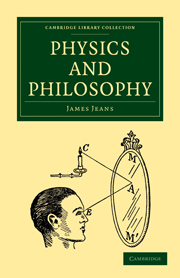Book contents
- Frontmatter
- Contents
- Preface
- I What are Physics and Philosophy?
- II How do we know? (Descartes to Kant; Eddington)
- III The two voices of Science and Philosophy (Plato to the present)
- IV The Passing of the Mechanical Age (Newton to Einstein)
- V The New Physics (Planck, Rutherford, Bohr)
- VI From Appearance to Reality (Bohr, Heisenberg, de Broglie, Schrödinger, Dirac)
- VII Some Problems of Philosophy
- Index
V - The New Physics (Planck, Rutherford, Bohr)
Published online by Cambridge University Press: 07 September 2010
- Frontmatter
- Contents
- Preface
- I What are Physics and Philosophy?
- II How do we know? (Descartes to Kant; Eddington)
- III The two voices of Science and Philosophy (Plato to the present)
- IV The Passing of the Mechanical Age (Newton to Einstein)
- V The New Physics (Planck, Rutherford, Bohr)
- VI From Appearance to Reality (Bohr, Heisenberg, de Broglie, Schrödinger, Dirac)
- VII Some Problems of Philosophy
- Index
Summary
Preliminary Survey
With the coming of the twentieth century, there came into being a new physics which was especially concerned with phenomena on the atomic and sub-atomic scale. It brought with it a new way of interpreting the phenomena of inanimate nature, which was destined in time to sweep away all the difficulties besetting the old classical mechanics. A preliminary glance over the vast territory of this new physics reveals three outstanding landmarks.
First we notice an investigation which Prof. Planck of Berlin published in 1899. His aim was so to amend the classical mechanics that it should fit the observed facts of radiation, and show why the energy of bodies was not wholly transformed into radiation. We have already seen that this was likely to involve giving up either continuity or causality or the representation of phenomena as changes taking place in space and time. Actually his investigation seemed to show that continuity had to be given up, suggesting that in the last resort changes in the universe do not consist of continuous motions in space and time, but are in some way discontinuous.
The classical mechanics had envisaged a world constructed of matter and radiation, the matter consisting of atoms and the radiation of waves. Planck's theory called for an atomicity of radiation similar to that which was so well established for matter.
- Type
- Chapter
- Information
- Physics and Philosophy , pp. 126 - 152Publisher: Cambridge University PressPrint publication year: 2009First published in: 1942



